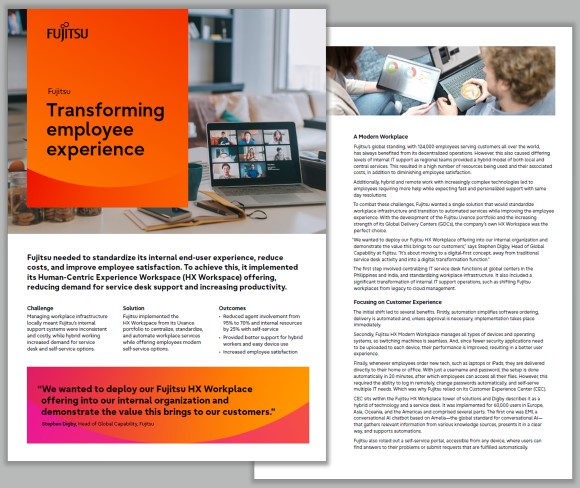Fujitsu
Transforming employee experience

Fujitsu needed to standardize its internal end-user experience, reduce costs, and improve employee satisfaction. To achieve this, it implemented its Human-Centric Experience Workspace (HX Workspace) offering, reducing demand for service desk support and increasing productivity.
Challenges
Managing workplace infrastructure locally meant Fujitsu’s internal support systems were inconsistent and costly, while hybrid working increased demand for service desk and self-service options.
Solutions
Fujitsu implemented the HX Workspace from its Uvance portfolio to centralize, standardize, and automate workplace services while offering employees modern self-service options.
Outcomes
- Reduced agent involvement from 95% to 70% and internal resources by 25% with self-service
- Provided better support for hybrid workers and easy device use
- Increased employee satisfaction
“We wanted to deploy our Fujitsu HX Workspace offering into our internal organization and demonstrate the value this brings to our customers.”
Stephen Digby, Head of Global Capability, Fujitsu
1
platform for consistent
employee experience
60,000
users supported
500+
use cases enabled
- Industry: IT services, solutions, and technology
- Location: Global
- Customer's website

About the customer
Since its beginnings in 1935, Fujitsu has been innovating information and communication technologies around the world, becoming a leading company in the industry. Fujitsu’s purpose is to make the world more sustainable by building trust in society through innovation while offering a broad range of products, services, and solutions, globally.
Fujitsu’s global standing, with 124,000 employees serving customers all over the world, has always benefited from its decentralized operations. However, this also caused differing levels of internal IT support as regional teams provided a hybrid model of both local and central services. This resulted in a high number of resources being used and their associated costs, in addition to diminishing employee satisfaction.
Additionally, hybrid and remote work with increasingly complex technologies led to employees requiring more help while expecting fast and personalized support with same day resolutions.
To combat these challenges, Fujitsu wanted a single solution that would standardize workplace infrastructure and transition to automated services while improving the employee experience. With the development of the Fujitsu Uvance portfolio and the increasing strength of its Global Delivery Centers (GDCs), the company’s own HX Workspace was the perfect choice.
“We wanted to deploy our Fujitsu HX Workspace offering into our internal organization and demonstrate the value this brings to our customers,” says Stephen Digby, Head of Global Capability at Fujitsu. “It’s about moving to a digital-first concept, away from traditional service desk activity and into a digital transformation function.”
The first step involved centralizing IT service desk functions at global centers in the Philippines and India, and standardizing workplace infrastructure. It also included a significant transformation of internal IT support operations, such as shifting Fujitsu workplaces from legacy to cloud management.
Focusing on Customer Experience
The initial shift led to several benefits. Firstly, automation simplifies software ordering, delivery is automated and, unless approval is necessary, implementation takes place immediately.
Secondly, Fujitsu Modern Workplace manages all types of devices and operating systems, so switching machines is seamless. And, since fewer security applications need to be uploaded to each device, their performance is improved, resulting in a better user experience.
Finally, whenever employees order new tech, such as laptops or iPads, they are delivered directly to their home or office. With just a username and password, the setup is done automatically in 20 minutes, after which employees can access all their files. However, this required the ability to log in remotely, change passwords automatically, and self-serve multiple IT needs. Which was why Fujitsu relied on its Customer Experience Center (CEC).
CEC sits within the Fujitsu HX Workspace tower of solutions and Digby describes it as a hybrid of technology and a service desk. It was implemented for 60,000 users in Europe, Asia, Oceania, and the Americas and comprised several parts. The first one was EMI, a conversational AI chatbot based on Amelia—the global standard for conversational AI— that gathers relevant information from various knowledge sources, presents it in a clear way, and supports automations.
Fujitsu also rolled out a self-service portal, accessible from any device, where users can find answers to their problems or submit requests that are fulfilled automatically. The self-service password resets alone made a huge difference as, in the past, password changes made almost 20% of all service desk requests.
EMI and the self-service portal remove the need for personal support. However, if the two options ever prove ineffective, AWS Connect enables live agent support translated into the employee’s own language. This is rarely needed. For example, since the implementation in France, Spain, and Portugal, no escalation issues have been received from these regions.
“We introduced multiple technologies across many regions,” says Digby. “The challenge would have been a deterrent to some, so I’m proud of the team for working relentlessly to transition from using old, established methods and processes to new, technology-based digital tools and practices.”
These new tools have allowed the number of internal resources to steadily decrease. In less than two years, FTEs have gone down from 117 to 88 while agent involvement has dropped from 95% to 70%. Fujitsu’s focus on making the most of its own solution also led to a staggering number of use cases that support natural language processing and help EMI better understand user requests. “We have about 525 use cases created internally to meet the specific business challenges that Fujitsu employees face,” comments Digby.
According to Digby, the transformation also supports Fujitsu’s sustainability efforts. For example, “EMI helps reduce on-site IT support visits, lowering our environmental impact and minimizing energy consumption. It also educates users about sustainable practices, such as optimizing processes, thereby reducing paper usage and human labor.”
However, CEC doesn’t simply focus on the number of improvements or tickets resolved but also on a positive employee experience, so measuring results is vital. To establish trusted baselines and track feedback, the team relied on HappySignals, an experience management platform, allowing Fujitsu to implement ongoing changes based on the results and improve user experience.
Leading by Example
Fujitsu implements the new HX Workspace developments internally first and proves its capabilities. Fujitsu’s own transformation also showed the importance of stakeholder commitment in large-scale implementations.
“The solution offers increasing year-on-year savings through the transformation of the service desk, an ongoing headcount reduction, an increase in use cases, and knowledge base growth,” explains Digby. “There’s a lot of effort upfront, but you see consistent benefits each year due to reducing costs and utilizing more technology. But to do that, you need the stakeholders to mandate, adopt, and utilize.”
Fujitsu leadership believe in the importance of global standardization, resulting in time and cost savings as well as happier employees. The latter can be easily shown through feedback from staff who appreciate the quick and efficient services.
“We’ve been able to learn from the experience,” summarizes Digby. “And now, the use cases that we’re building for our customers will be even more detailed, wide-ranging, and educated.”
Related Customer stories




